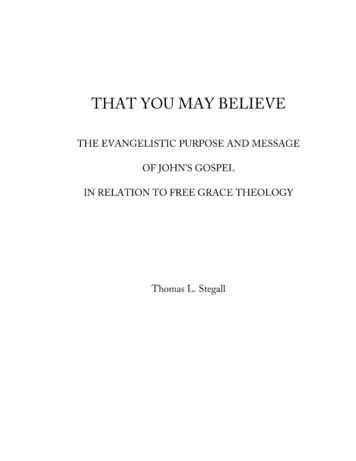
Transcription
That You May Believe: The Evangelistic Purpose and Messageof John’s Gospel in Relation to Free Grace Theology 2017 Thomas L. StegallThis document is a revised version of a dissertation by the same title presented to thefaculty of Grace Biblical Seminary in June 2017. It is made available here by their kindpermission with a few revisions, including changes to some of the original formatting, therewording of certain sections, and the addition of a chapter on the date of John’s Gospel,which was previously published separately.I am grateful to my family for their love, support, and encouragement throughout thesestudies. By the abundant grace and mercy of our God, may He be pleased now to use thisdissertation on the Gospel of John as a helpful resource in the lives of those who chooseto read it. Studying this rich and rewarding portion of God’s Word, with its focus on theperson, work, and provision of the Savior, has been one of the greatest joys and privilegesof my life. May the Lord Jesus Christ be magnified as a result and receive the glory dueHis name.The works of the LORD are great,studied by all who have pleasure in them.(Ps. 111:2)Worthy is the Lamb who was slainto receive power and riches and wisdom,and strength and honor and glory and blessing!(Rev. 5:12)
ABSTRACTTHAT YOU MAY BELIEVE: THE EVANGELISTIC PURPOSE AND MESSAGEOF JOHN’S GOSPEL IN RELATION TO FREE GRACE THEOLOGYThis dissertation seeks to determine the primary purpose and message of John’s Gospel,so that the teachings of Free Grace theology based on this Gospel may be confirmed,clarified, or corrected. The conclusion from the exegetical evidence is that John’s primarypurpose is evangelism of unbelievers, as the book seeks to lead its readers to fulfill thesingle, instantaneous condition of belief in Jesus Christ’s person, work, and promise inorder to receive the free gift of eternal life that cannot be lost.Background study on the date and intended readers of John’s Gospel isfoundational to the study of its purpose. A survey of the evidence leads to a reasonabledate range in the 60s–90s A.D. with John being the fourth Gospel published, in contrastto the claims of some Free Grace proponents that it was completed in the 30s–45 A.D.Thus, John’s Gospel does not have theological priority over other New Testament booksbased on an alleged chronological priority.The profile of John’s intended reader is gleaned primarily from textual cluesimplicit within his Gospel, leading to the conclusion that John has the broadest possibleapplication to Jews, Samaritans, and Gentiles, having been written for the salvation of thewhole world. Several lines of evidence show that John was written directly to unbelieversfor the primary purpose of evangelism that promises unending, divine life, while thebook’s secondary purpose is the edification of those who are already believers.Examination of John’s use of pisteuvw shows that eternal life results from asingle act of faith. Supposed proof texts in John’s Gospel do not teach that eternal life isdependent on, or necessarily proven by, perseverance in faith and good works, which arethe manifestation of abiding in dependent fellowship with Christ as His disciple. John’sGospel supports Free Grace theology’s doctrine of the nature of “saving faith.”John’s content or object of faith for eternal salvation in the present age isexpressed through the book’s consummate view of Jesus as “the Christ, the Son of God.”While many current proponents of Free Grace theology teach that to receive regenerationJohn’s Gospel requires belief only in Jesus’ promise of eternal life, irrespective of anyknowledge of, or belief in, His person and work, John’s Gospel actually teaches thatbelief in Jesus Christ as the object of “saving faith” has requisite content that includes:the promised gift of eternal life, Jesus’ identity as the unique Son of God, who is bothfully God and human, who died a substitutionary death for sin and rose from the dead.This content of “saving faith” does not necessitate belief in Jesus Christ’s virgin birth,burial, status as a prophet and national king, Davidic lineage, and Second Coming.While the primary purpose of John’s Gospel is evangelism, it is not the onlyevangelistic book in the Bible, as many Free Grace adherents claim. A comparison ofJohn’s Gospel with Romans and Luke-Acts shows that each of these books shares thesame saving message. Christians today are not limited to John’s Gospel alone forevangelizing the lost with the saving message of the gospel of Christ.iii
TABLE OF CONTENTSTables and Figures . xiChapter1.INTRODUCTION .1Reasons for This Study .2Assumptions of This Study .8Limitations of This Study .9Procedure of This Study.10Overview of This Study .112.THE DATE OF JOHN’S GOSPEL .14Introduction .14Johannine Priority .15Apostolic Authorship .15Order of Composition .16Evidence for a Later Date (A.D. 80s–90s) .18False Assumptions .18Destruction of Jerusalem.21Temple Replacement Theme .22Absence of Sadducees.23Sea of Tiberias .25Death of John & the Lord’s Return.25Evidence for an Earlier Date (Pre-A.D. 70) .27A.D. 70 and the Destruction of the Temple .28iv
John 5:2 and the Historical Present .29Jewish Missions Document.31Aramaic Original .32Other Voices for an Early Dating of John .33Obstacles to the Priority of John’s Gospel .35John and Gentile Missions .35No Intratestamental References to the Gospel of John .36John’s Significant Omissions and Additions .37Twelve Disciples Assumed in John’s Gospel .40John the Baptist Assumed in John’s Gospel .40Gospel of Mark Assumed in John’s Gospel .41No Synoptic Literary Collaboration with John’s Gospel .42Patristic Testimony on the Order of the Gospels .43Conclusion .433.THE AUDIENCE OF JOHN’S GOSPEL .45Evidence for a Jewish Audience .45Provenance of John’s Gospel .45Old Testament Background .48Prevalence of “the Jews” .50Jewishness of Jesus .52Messiahship of Jesus .52Omission of the Great Commission .55Samaritans .57Evidence for a Gentile Audience .58v
Gentiles versus Diasporic Jews .58Identification of Geography and Topography.59Interpretation of Aramaic Words .60Interpretation of Jewish Customs and Feasts .60Universal Scope of John’s Gospel .61Omission of the “Gentiles” .63Conclusion .644.THE PURPOSE OF JOHN’S GOSPEL .66Edification of Believers .66Upper Room Discourse .66John’s Epilogue.68Developing Faith of the Disciples.692 Timothy 3:16–17 Principle .73Evangelization of Unbelievers .73Contrast with 1 John .73Pivot of the Prologue’s Chiastic Structure .75Predominant Usage of Pisteuvw .76Pronoun Identifiers.78Possession of Everlasting Life .83Conclusion .905.THE MEANING AND NATURE OF PISTEUW IN JOHN’SEVANGELISTIC MESSAGE .92Text, Syntax, and Semantics of Pisteuvw in John 20:31 .92Instantaneous versus Persevering Belief .98vi
Present, Substantival Participle of Pisteuvw . 101Believing Illustrated by Looking (3:14–15) .109Believing Illustrated by Drinking (4:13–15).112Believing Illustrated by Eating (6:31–35).112Pisteuv[s]hte and Pisteuvonte in John 20:31 .114Believing and Volition .115Believing, Works, and Grace .117Believing and Assurance.124Perseverance & Performance Proof Texts .130Untrustworthy Believers (2:23–25) .131Believers Who Do the Truth (3:19–21) .132Disobedience of Unbelief (3:36) .141Resurrection Rewards for Good and Evil (5:28–29) .144Believers Who Abide for Discipleship (8:30–32) .146Believers Who Abide as Fruitful Disciples (15:1–6).148Conclusion .1566.THE OBJECT AND CONTENT OF PISTEUW IN JOHN’SEVANGELISTIC MESSAGE .157Placement & Perspective of John 20:30–31 .157Immediate Context of John 20:30–31 .159“Signs” in John 20:30–31 .161“The Christ, the Son of God” in John 20:30–31 .169Deity of Jesus the Christ .184Humanity & Death of Jesus the Christ .194vii
Resurrection of Jesus the Christ.209Words, Works, and Person of Christ .213Works, the Father, and Scripture .215Jesus’ “Name” in John 20:31 .217Syntax and Translation of 20:31b .218Meaning of “Name” .219Life in/by His Name.222Conclusion .2257.THE CONTENT OF PISTEUW NOT INCLUDED IN JOHN’SEVANGELISTIC MESSAGE .228Jesus’ Virgin Birth .228Jesus’ Burial .231Jesus as Prophet .234Prophet Passages in John’s Gospel .234Samaritan Concept of Messiah (John 4) .237Jesus’ Davidic Lineage .242Davidic Lineage in John’s Gospel .242Jewish Expectations of Davidic Messiah .243Additional Reasons Excluding Davidic Lineage .245Jesus as National King .247Unique Concept of Christ’s Kingship .247Kingship Passages in John’s Gospel .249Lordship Salvation Concept of Kingship .256Jesus’ Second Coming .258viii
Conclusion .2608.THE EVANGELISTIC PURPOSE OF OTHERBIBLICAL BOOKS RELATIVE TO JOHN’S GOSPEL .262Claims for the Exclusiveness of John’s Gospel .262Gospel of John and Epistle of Romans .264Purpose of Romans .265Problems with Pitting John against Romans .268Parallels between John and Romans .270Gospel of John and Gospel of Luke .275Prologue of Luke-Acts .277Theophilus: Believer or Unbeliever? .283Certainty and Assurance .286Catechized or Evangelized? .289Content of Luke-Acts .292Luke-Acts: A Unit.293Theme and Purpose of Fulfillment .294Theme and Purpose of Salvation in Christ .296Person of Christ.298Gracious Savior .299Thief on the Cross .302Political Purpose .304Ecclesiastical Purpose .307Evangelism, Edification, or Both? .308Conclusion .309ix
9.CONCLUSION .310Date, Audience, and Purpose .310Meaning and Nature of Pisteuvw .312Object and Content of Pisteuvw.313APPENDIX: Born of Water and Spirit (3:5) .320WORKS CITED .329x
TABLES AND FIGURESTables1.Inceptive versus Developing Faith in John’s Gospel .772.Pisteuvw Constructions in John’s Gospel .1233.Jesus’ Burial and Scriptural Fulfillment Pattern in John 19–20 .2324.Jesus’ Burial and Scriptural Fulfillment Pattern in 1 Corinthians 15:3–5 . 2335.Jesus’ Burial and Scriptural Fulfillment Pattern in Acts 13 .234Figures1.The Pivot of the Prologue’s Chiastic Structure.762.John’s Consummate View of Jesus as the Christ, the Son of God .2553.The Flow of Thought in John 3:3–6 .323xi
CHAPTER 1INTRODUCTIONEvery book of the Bible is equally inspired by God (2 Tim. 3:16), but certain bookswithin the canon of Scripture seem to play a larger role in the plan of God. This iscertainly true with the Gospel of John, which is widely regarded as one of the mostinfluential, popular, and widely read books in the Bible. The large number and the highpercentage of extant Greek manuscripts of John attest to the fact that it was one of themost frequently copied books by the early church.1John’s Gospel has also proven to be one of the most useful books of the Biblefor personal evangelism over the centuries. Many believers in Jesus Christ today,including this writer, can recall with deep gratitude specific passages from John that theLord used to assure them of Christ’s finished work, the simplicity of faith in Him as thesole condition for salvation, and the personal2 possession of everlasting life.The Gospel of John not only plays a central role in God’s purpose ofevangelism toward the lost but also theologically for the doctrines of soteriology andChristology.3 John’s simple language not only allows unbelieving, first-time readers andnewborn Christians to easily understand its message, but this Gospel also contains someof the deepest, richest, and most profound theology of any book in the Bible. Thesignificant role that John’s Gospel has had in Christianity is beyond dispute. But since somany books and studies on the Gospel of John exist already, why is there a need foranother?1Currently there are over sixty extant papyrus and uncial manuscripts containing portions orall of the Greek New Testament that date to the second and third centuries. The Gospel of John is the mostattested book of the New Testament among this group with eighteen manuscripts. The Gospel of Matthewis next with twelve manuscripts. This general pattern of attestation continues over the centuries as oneconsiders the remaining copies of minuscule manuscripts and versions. See Kurt Aland and Barbara Aland,The Text of the New Testament: An Introduction to the Critical Editions and the to the Theory and Practiceof Modern Textual Criticism, rev. ed., trans. Erroll F. Rhodes (Grand Rapids: Eerdmans, 1987), 85; LarryW. Hurtado, The Earliest Christian Artifacts: Manuscripts and Christian Origins (Grand Rapids:Eerdmans, 2006), 20; Michael J. Kruger, Canon Revisited: Establishing the Origins and Authority of theNew Testament (Wheaton, IL: Crossway, 2012), 234-35.2Readers of John’s Gospel often note its highly personal nature, but few studies have beendevoted to this subject. For a recent exception, see the chapter on “Individualism” in Richard Bauckham,Gospel of Glory: Major Themes in Johannine Theology (Grand Rapids: Baker Academic, 2015), 1-19. Seealso, C. F. D. Moule, “The Individualism of the Fourth Gospel,” Novum Testamentum 5 (July 1962): 17190.3Michael D. Halsey, The Gospel of Grace and Truth: A Theology of Grace from the Gospelof John (Duluth, MN: Grace Gospel Press, 2015), 85; Andreas J. Köstenberger, A Theology of John’sGospel and Letters (Grand Rapids: Zondervan, 2009), 316.1
2REASONS FOR THIS STUDYThere exists a need for an in-depth study of the date, audience, purpose, and savingmessage of John’s Gospel because of the sharp disagreement today between segments ofReformed and Free Grace evangelicalism over John’s teaching on the reception of eternallife through faith in Jesus Christ. From the Reformed theological perspective, the purposeand message of John’s Gospel is often regarded as evangelistic but only through thetheological prism of perseverance theology with its requirement of a productive andenduring faith as the necessary result of regeneration and genuine initial belief in Christ.4Consequently, there is a need to reexamine John’s evangelistic purpose and message withspecial attention given to the nature of belief in Christ for eternal salvation. Does John’sevangelistic message teach that not only does belief in Jesus Christ result in eternal life,but true “saving faith”5 will always persevere and be productive to the end of one’s life?Conversely, many who reject the lordship salvation of Reformed theology andespouse Free Grace theology hold that John’s Gospel has theological priority as the onlyevangelistic book in the Bible6 and that John’s “saving message”7 states that the lost may4D. A. Carson, Divine Sovereignty and Human Responsibility: Biblical Perspectives inTension (Grand Rapids: Baker, 1994), 194-95; John F. MacArthur, Jr., The Gospel According to Jesus(Grand Rapids: Zondervan, 1988), 37-58; Ernest C. Reisinger, Lord & Christ: The Implications of Lordshipfor Faith and Life (Phillipsburg, NJ: Presbyterian & Reformed, 1994), 4, 40; Robert L. Reymond, John,Beloved Disciple: A Survey of His Theology (Fearn, Great Britain: Christian Focus, 2001), 86-88, 127-34.For an in-depth response to perseverance theology and how it has changed the nature of the gospel fromgrace to works, see Thomas L. Stegall, Must Faith Endure for Salvation to Be Sure? A Biblical Study of thePerseverance Versus Preservation of the Saints (Duluth, MN: Grace Gospel Press, 2016).5As used throughout this dissertation, the expression “saving faith” does not mean a specialquality of faith, such as working faith, obedient faith, persevering faith, heart faith versus head faith, and soforth. Though many adherents of Lordship Salvation use “saving faith” with this meaning, nowhere inScripture does God require a special quality or kind of faith to be eternally saved. Biblically, salvation is amatter of having the right content or object of one’s faith (Charles C. Bing, Lordship Salvation: A BiblicalEvaluation and Response, GraceLife ed. [Burleson, TX: GraceLife Ministries, 1992], 57). Robert Lightnerexplains: “Sometimes people speak of ʻsaving faith.ʼ By this they imply faith for salvation is different fromfaith exercised for other things. But God does not require some special kind of faith for salvation differentfrom ordinary faith. . . . It is not, however, the person’s faith which saves. The New Testament teaches thatChrist and Christ alone saves. No one can be saved without faith in the Lord Jesus Christ and His death inthe sinner’s place. But it is not the kind nor the amount of faith that brings life to the one dead in trespassesand sin” (Robert P. Lightner, Sin, the Savior, and Salvation: The Theology of Everlasting Life [Nashville:Thomas Nelson, 1991], 240). Thus, to have faith in one’s works plus Jesus means that one’s faith ismisplaced and will not result in salvation—it is not “saving” (Rom. 4:5). To have faith in Jesus Christ aloneis to have a faith that will save, hence a “saving faith.” The real question regarding salvation is not, “Whatkind of faith do I have?” but “Who or what am I trusting to be saved?” Though the phrase “saving faith”never occurs in the Bible and can be easily misconstrued, it is used here with these qualifications because itis still common theological language pertaining to both the nature and content of faith for eternal life.6Bob Bryant, “The Search for the Saving Message Outside of the Gospel of John,” GraceEvangelical Society Conference, Fort Worth, TX, March 6, 2008; John Niemelä, “Greetings,” Message ofLife Ministries. www.mol316.org/pages/greetings.html (accessed February 9, 2009); Robert N. Wilkin,“The Gospel According to Evangelical Postmodernism,” Journal of the Grace Evangelical Society 20(Spring 2007): 11.7The phrase “saving message” must also be clarified. My own view expressed throughout thisdissertation is that the “saving message” is synonymous with “the gospel of Christ,” which is the messageGod requires the lost to believe in order to have eternal life. However, “saving message” has become a
3be regenerated simply by believing Jesus guarantees everlasting life, regardless of whatother knowledge they may have or what misconceptions they may hold about Him.8According to this recent theological view, John’s Gospel does not require belief in JesusChrist’s deity, substitutionary death, or bodily resurrection in order to receive eternallife.9 Those Free Grace proponents who hold to this “promise of life” or “promise-only”view of the saving message10 consider it to be “theological legalism”11 or “doctrinallegalism”12 to interpret John’s Gospel as requiring belief in Jesus’ deity, death for sin,and resurrection for eternal life. This stands in contrast to the classical Free Grace view ofthe contents of “saving faith,” in which these elements have been considered necessary tobelieve for eternal life.13 To date, no substantive written work has appeared that directlytechnical expression for many within the Free Grace community who view it as a narrower message than“the gospel,” which God supposedly does not require the lost to believe for eternal life (Bryant, “TheSearch for the Saving Message Outside of the Gospel of John”; Robert N. Wilkin, “Gospel Means GoodNews,” Grace Evangelical Society Southern California Regional Conference, August 24, 2007; idem, “IsIgnorance Eternal Bliss?” Journal of the Grace Evangelical Society 16 [Spring 2003]: 13). This studydistinguishes Matthew, Mark, Luke, and John as Gospels (capitalized), which contain good news aboutJesus Christ, from the gospel (lowercase), which is the particular “saving message” the lost must believe toreceive eternal life. Support for this distinction can be found in Thomas L. Stegall, “Is the Gospel a Broad,Non-Soteriological Message?” in The Gospel of the Christ: A Biblical Response to the Crossless GospelRegarding the Contents of Saving Faith (Milwaukee: Grace Gospel Press, 2009), 213-70.8Zane C. Hodges, “How to Lead People to Christ, Part 1: The Content of Our Message,”Journal of the Grace Evangelical Society 13 (Autumn 2000): 9; idem, “How to Lead People to Christ, Part2: Our Invitation to Respond,” Journal of the Grace Evangelical Society 14 (Spring 2001): 12; Robert N.Wilkin, Secure and Sure (Irving, TX: Grace Evangelical Society, 2005), 74-75.9Hodges, “How to Lead People to Christ, Part 1,” 6-7; René A. López, Romans Unlocked(Springfield, MO: 21st Century Press, 2005), 212; John Niemelä, “The Message of Life in the Gospel ofJohn,” Chafer Theological Seminary Journal 7 (July-September 2001): 18; Robert N. Wilkin, GraceEvangelical Society News (June 1990): 4.10“Promise-only” is an apt description of this view of the saving message or content of faithfor eternal life. Though advocates of this view generally eschew this label, along with others such as“crossless gospel,” they nevertheless teach that God requires only the promise of eternal life to be believedfor regeneration, rather than belief in the promise, person (deity, humanity), and work (substitutionarydeath, resurrection) of Christ. John Niemelä espouses the “promise-only” view and writes: “John oftenrecords Jesus telling groups of unbelievers how to receive everlasting life. His message of life tounbelievers is a one-step pronouncement: The promise of life for the believer. It is not a two-step message:First explaining why He is able to give life [i.e., because of His deity, humanity, death, and resurrection]and second explaining the promise” (“Who Is Able to Guarantee Everlasting Life?” Grace in Focus 23[November-December 2008], 3).11Zane C. Hodges, “The Hydra’s Other Head: Theological Legalism,” Grace in Focus 23(September/October 2008): 2.12Bob Wilkin, “Essential Truths About Our Savior,” Grace in Focus 23 (NovemberDecember 2008): 2; idem, “Scavenger Hunt Salvation Without a List,” Grace in Focus 23 (May-June2008): 1.13Bing, Lordship Salvation, 57; Lewis Sperry Chafer and John F. Walvoord, Major BibleThemes, rev. ed. (Grand Rapids: Eerdmans, 1974), 60; Fred Chay, The Glorious Grace of God:Understanding Free Grace Theology (n.p.: Grace Line, 2009), 14; G. Michael Cocoris, Evangelism: ABiblical Approach (Chicago: Moody, 1984), 61, 74; idem, The Salvation Controversy (Santa Monic
While the primary purpose of John’s Gospel is evangelism, it is not the only evangelistic book in the Bible, as many Free Grace adherents claim. A comparison of John’s Gospel with Romans and Luke-Acts shows that each of these books shares the same saving message. Ch











